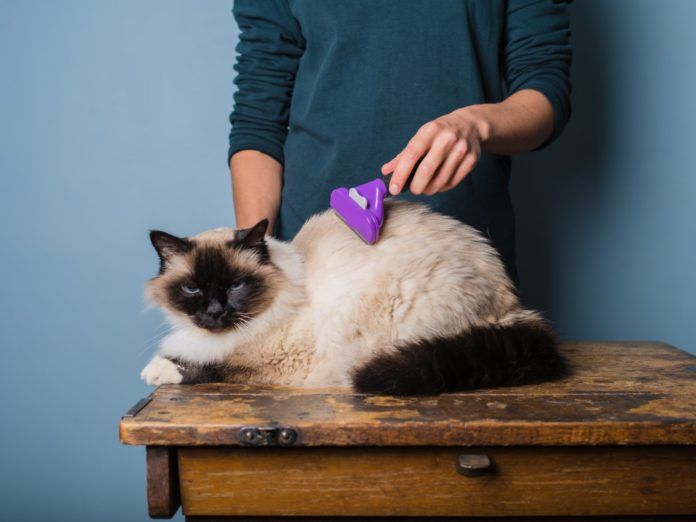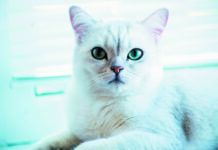Cats are known as naturally fastidious animals, and their meticulous hygiene habits make them a favored pet for many people and cultures. Cats come equipped with their own built-in grooming accessories: the barbed tongue combs out dead loose fur while saliva is a cleaning agent; the front paws become a loofah to clean around the face and ears; the incisors, the tiny front teeth, tease out tangles and remove debris; and the back paws replicate a wide-tooth comb.
Even with these natural grooming tools and many waking hours spent self-grooming, some cats need daily or weekly grooming assistance from their owners to truly maintain their coat, skin and overall health. For many cats, and cat owners, it’s a mat, mat world — but it needn’t be if you’re equipped with the right knowledge and appropriate tools.
How Mats are Created in Cat Hair
To better understand mats in cats, let’s briefly recap shedding. Seasonal shedding — with the two biggest shedding times of the year occurring in fall and spring — correlates with the amount of sunlight during the day. However, indoor cats shed year-round due to the constant artificial light in our homes; so instead of two heavy bouts of shedding, indoor cats experience continual light shedding. And it is the sloughing of dead hair that contributes to the baneful matting in a cat’s fur.
Mats tend to form in hard to reach places such as under the front legs (armpits), stomach, and the rear area around the base of the tail, flanks and sensitive nether regions.
“Mats in cats are generally different from those in dogs and humans,” explains Lynn Paolillo, CFMG, CFCG, DTS and certifier and head instructor at National Cat Groomers Institute of America, Inc., in Greenville, South Carolina. “Instead of just tangled hair, cat mats are caused by an excess of dead coat that sheds out and greasy, oily skin. The dead coat clumps together with oils, eventually becoming large and hard mats. This pelting is similar in texture to a Brillo pad.”
All Cat Fur Types are Susceptible to Matting
The luxurious coat of long-haired cats obviously requires more grooming to maintain those illustrious good looks, but most cats are prone to matting. Short-haired cats are not exempt — excessive shedders are susceptible to mats. Senior cats have a greater difficulty grooming themselves in part due to arthritis and the stiffness that naturally comes with advancing age. The coat and skin health in older cats deteriorates as they age, plus their skin produces excess oils, explains Paolillo. And overweight cats need extra help grooming simply because they cannot reach all parts of their bodies, and therefore also prone to matting.
“The color of the cat can also have an effect on how quickly they mat. Some colors mat faster than others, as the hair is more cottony in colors like cream, blue and some white cats,” says Paolillo. “All cats are at risk of matting, but age, health, the amount of coat they have and color will affect how quickly they mat.”
Mats in Fur Can Lead to Health Issues
Mats are much more than an aesthetic problem — they also can cause discomfort and lead to dermatologic problems. Cats have thin, sensitive skin and mats pinch the skin to the point of not only being painful but hindering movement. Paolillo says mats cause skin irritations and bald spots and hide preexisting conditions such as fleas, ticks and wounds, among others.
Scheduling regular grooming sessions is proactive prevention to taming the unruly tangles before they become a matted mess. Starting early with kittens is the best approach, but even wary adults can be gradually desensitized to the grooming process by starting with short sessions and associating the task with positive rewards like treats.
The proper tools are a must. Paolillo recommends using a metal comb with tines that are smoothed or ground down — not a flea comb — to remove the excess hair and distribute natural oils in the skin. She says brushes (pin brushes, natural bristle brushes, and de-shedding rakes) are ineffective or are too harsh for a cat’s sensitive skin, and that only metal combs are used at her salon. When combing your cat, be gentle; pulling and tugging at mats and tangles hurts your sensitive-skinned cat.
Seeking Professional Help for Matted Cat Fur
Even when you’ve done your very best and followed a grooming routine with your cat, chances are your cat may still get some mats. Of course it’s important to remove them as soon as possible, but sometimes the severity can get overwhelming — for example, if you’ve been traveling and the regular grooming schedule has been thrown off. Then it’s time to call in a professional groomer.
According to Paolillo, there are different ways to remove mats and the technique used greatly depends on the severity, the location, your cat’s skin condition and your cat’s tolerance to the grooming process. Smaller mats can be gently combed out once the coat is clean and dry but larger, severe mats should be shaved out by a professional groomer, says Paolillo. “Cats should only be shaved by someone who has been trained to do so safely, as cat skin is very delicate and can be cut easily with sharp equipment.”
Build Your Cat’s Relationship with Grooming
Paolillo recommends building a relationship with a professional cat groomer before your cat becomes matted. Starting early in a kitten’s life teaches them that the salon isn’t a scary place. For those cats who don’t travel well or get too stressed, there are mobile groomers available for you to schedule an appointment in your home.
“Cats are prone to stress-related medical problems, so it’s important to make the cat comfortable with the process,” she says. “Regular appointments with a professional cat groomer prevents mats and other problems, including greasy ears, ingrown nails, hairballs and excessive shedding.”
Not only can early preventative care help a cat stay mat-free, the groomer can help alert owners to any changes in behavior or health, says Paolillo.
Cats are naturally haute-couture creatures that try to maintain themselves to high standards. However, they sometimes need our assistance with grooming to keep their coats and skin in optimal condition. With the proper tools — which may include the help of a professional cat groomer — patience and perseverance, you can banish those maddening mats.
My Own Cat’s Matted Coat
The inspiration for this article is my 10-year-old Siberian, Ivan. For the
majority of his life, his long, feathery triple coat has been easy to care for with grooming sessions everyday, or at the very least, several days a week. Last year he had small clumps for the first time, and I mostly attributed it to the fact that I had been out of town so often and had to play catch-up on combing his fur to get it tangle-free.
However, this year he had unprecedented tangles and clusters of small mats from his armpits to britches and nether regions, despite daily combing. Grooming time has always been a special bonding time between us and I didn’t want the attempts at mat removal to turn the happy time into a negative. The smarty cat began running away when he saw me put on my glasses at grooming time! (Confession: Yes, I even resorted to cutting them out with scissors and Lynn Paolillo’s comment about skin getting caught up in mats made my stomach lurch at the risk I took.)
The problem got so bad that I posted a plea for suggestions on Facebook and received some ideas including different types of combs, brushes, de-shedders, de-tangling sprays and shampoos, and even using baby powder or corn starch. I usually take the simplest approach first so I started with a dusting of corn starch and a wide-toothed metal comb, which I normally use.
I discovered how fine and messy corn starch is; it got on my pants, carpet,
kitchen floor — basically everywhere except on the intended matted fur! I did work some of it into the largest mat, then I slowly worked the mat loose with my fingers. After that I held the mat in my fingers and combed from the base of the mat outwards, finally releasing it enough to comb out the clump of dead hair.
Over several weeks, with much trial and error on my part, Ivan’s waning patience, and treats — lots of treats — Ivan is now mat-free.





Ha! Thats so funny that he runs when you put on your glasses! They are too smart for their own good! My kitty has tiny little ones. I am able to pull them apart and get bit at the same time! I was just wondering why. It sounds a little different that your cat tho. I thought I was going to hear something that was really upsetting. Thanks for educating us! Stay Healthy and kisses and hugs to your Ivan!
Jodi
Warning about dosing cats with Lactulose: put it in their food as it is tasteless; it mats their coat horribly if they twist and you miss their mouth for oral dosing. It dries to a sticky mess. Worse in long-haired cats.
If the mat isn’t too close to the skin, I slip a comb under it and snip it out with blunt nosed scissors. Not show worthy, but it’s fast. Sam seems to like it better than combing them out.